
Turkey Liquid paraffin supplier from UAE for Pharmaceuticals and Cosmetics
- Home
- Turkey Liquid paraffin supplier from UAE for Pharmaceuticals and Cosmetics

What is liquid paraffin?
Liquid paraffin, also known as mineral oil or white oil, is a highly refined, colorless and odorless mixture of liquid hydrocarbons obtained from petroleum. It is a type of mineral oil that is use in a variety of applications, including pharmaceuticals, cosmetics, food processing, and industrial processes.
Mineral oil
Mineral oil is a highly stable and inert substance that is use as a lubricant, a solvent, and as a barrier against moisture loss in skin care products. It is also use as a laxative to relieve constipation, as it helps to soften the stools and promote bowel movement. Additionally, it is used in the manufacture of some types of candles, and as a base oil in aromatherapy and massage oil. It is important to note that paraffin should only be used as directed and under the guidance of a healthcare professional, as it can have potential side effects if ingested or applied improperly.
How it is made?
It is producing from crude oil, which is a complex mixture of hydrocarbons that is extracted from the ground. The crude oil is first refin to remove impurities and separate it into different fractions, base on their boiling points.
Table of Contents
ToggleTo produce liquid paraffin, the crude oil is heated and distilled under vacuum to separate the heavier fractions of hydrocarbons, such as waxes and lubricating oils, from the lighter fractions. The lighter fractions are then further processed to remove any remaining impurities and to achieve the desired characteristics of the final product, such as color, odor, and viscosity.
The resulting mineral oil is a highly refined and purified mixture of straight-chain hydrocarbons that are odorless, tasteless, and colorless. It is important to note that the production is a complex and highly controlled process to ensure its purity and safety for use in various applications.
Specification of liquid paraffin
The specifications can vary depending on the intended use, but some of the general properties and characteristics of liquid paraffin include:
- Appearance: Clear, colorless liquid
- Odor: Odorless or a very faint mineral oil-like odor
- Density: 0.80-0.90 g/cm3
- Boiling Point: 280-350°C
- Flash Point: 170-220°C
- Viscosity: 10-100 centistokes (cSt) at 25°C
- Refractive Index: 1.460-1.470
- Solubility: Insoluble in water, soluble in organic solvents
- Purity: 99% minimum, with a maximum level of impurities such as sulfur, nitrogen, and aromatic hydrocarbons.
It is intended for pharmaceutical use must meet additional specifications, including compliance with pharmacopoeial standards such as the United States Pharmacopoeia (USP), European Pharmacopoeia (Ph. Eur.), or British Pharmacopoeia (BP). These standards specify the purity, composition, and physical and chemical properties require to be considered suitable for pharmaceutical use.
Mineral oil usage
It has a wide range of uses across various industries, including pharmaceuticals, cosmetics, food processing, and industrial processes. Here are some common uses of mineral oil:
- Pharmaceuticals: Liquid paraffin is used as a laxative to relieve constipation by softening stools and promoting bowel movements. It is also used in some ointments and creams as a moisturizer or as a base ingredient.
- Cosmetics: Liquid paraffin is used in a variety of cosmetic products, including skin creams, lotions, hair conditioners, and makeup products. It helps to hydrate and moisturize the skin and hair, and can also help to prevent water loss.
- Food processing: Liquid paraffin is used as a lubricant in food processing equipment to prevent sticking and improve the flow of food products. It is also used as a release agent for baked goods and as a coating for fruits and vegetables to improve their appearance and shelf life.
- Industrial processes: Liquid paraffin is used as a lubricant in various industrial processes, including textile manufacturing, metalworking, and paper production. It can also be used as a heat transfer fluid, a hydraulic fluid, and a transformer oil.
- Other uses: Liquid paraffin is also used in the production of candles, as a base oil in aromatherapy and massage oils, and as a coating for wooden surfaces to protect them from moisture and damage.
It is important to note that is use as directed and under the guidance of a healthcare professional, as it can have potential side effects if ingested or applied improperly.
Price of liquid paraffin
The price can vary depending on several factors, such as the quantity, quality, and the market demand. Additionally, different suppliers and distributors may offer different prices based on their production and distribution costs, location, and other factors.
Today price of liquid paraffin is 800$/MT on 19 of April 2023
Packing of mineral oil
New or second hand 180 kg drums, iso tank, flexi tanks.
Analysis of liquid paraffin
Items | Result | Test method |
Kin viscosity at 40 c | 19-21 cst | Astm d-445 |
Pour point (max) | 0-(-6) c | Astm d-97 |
Flash point | 197-215 c | Astm d-92 |
Density at 20 c | 0.827-0.890 gr/cm3 | B.p 2012 |
Color (lovibond) | 0.2y+0.2b | Ip-17 method a 2” cell |
Odour | Passed | B.p 2012 |
Acidity or alkalinity | Passed | B.p 2012 |
Solid paraffin | Passed | B.p 2012 |
Most sold in India
Share On
MSDS
Download MSDS of liquid paraffin
Specification
Download specification of liquid parafin
Contact Info
Turkey office:No.6 of Fahrettin Pasa Sokak , Galip Erdem steet, Ilkbahar Mah. Turan Gunes Ave. Çankaya Ankara
Phone: 00903125147055
Dubai office: 3509 of the Burligton tower, business bay, dubai-uae
Phone:0097142369830
E-Mail: [email protected]
